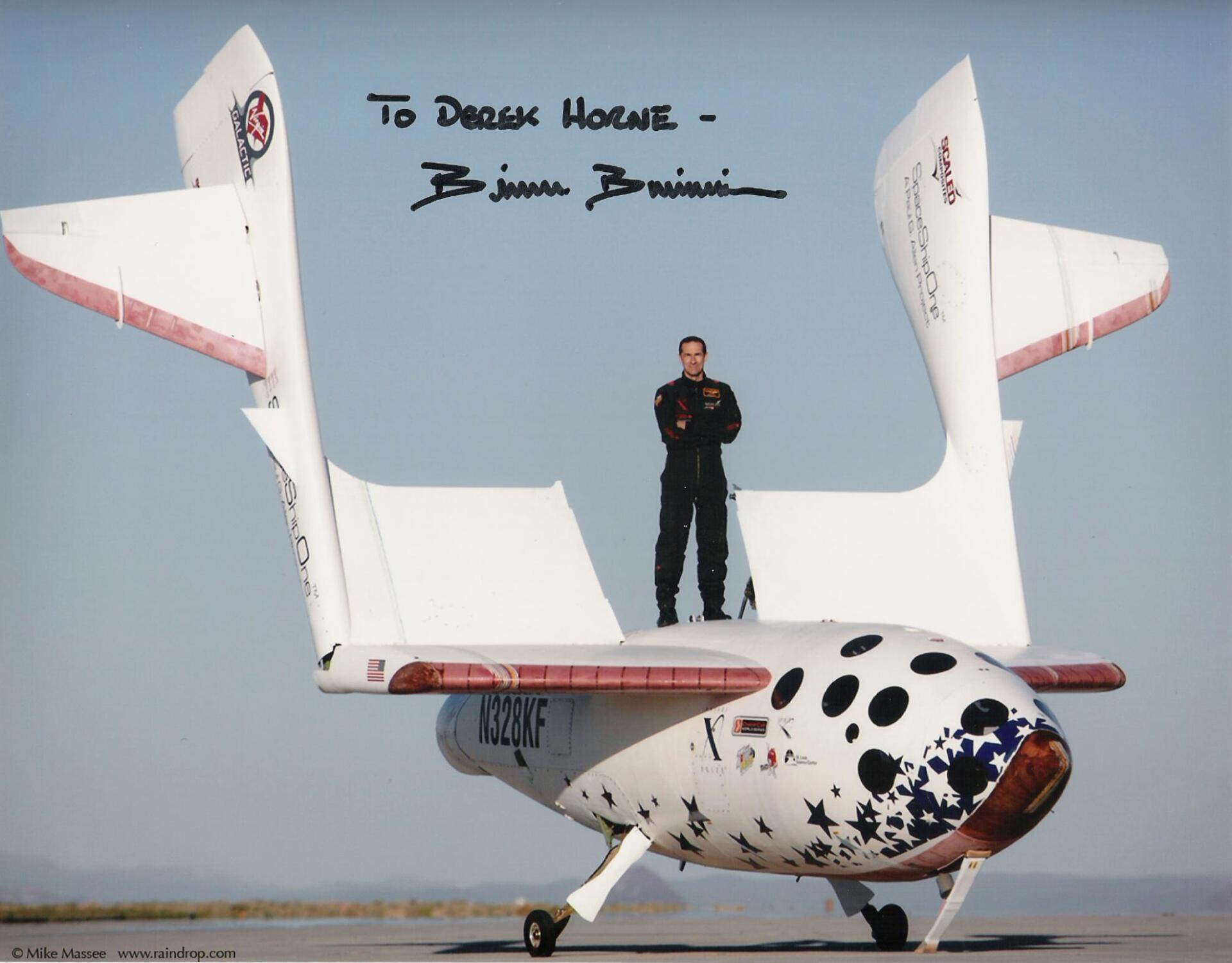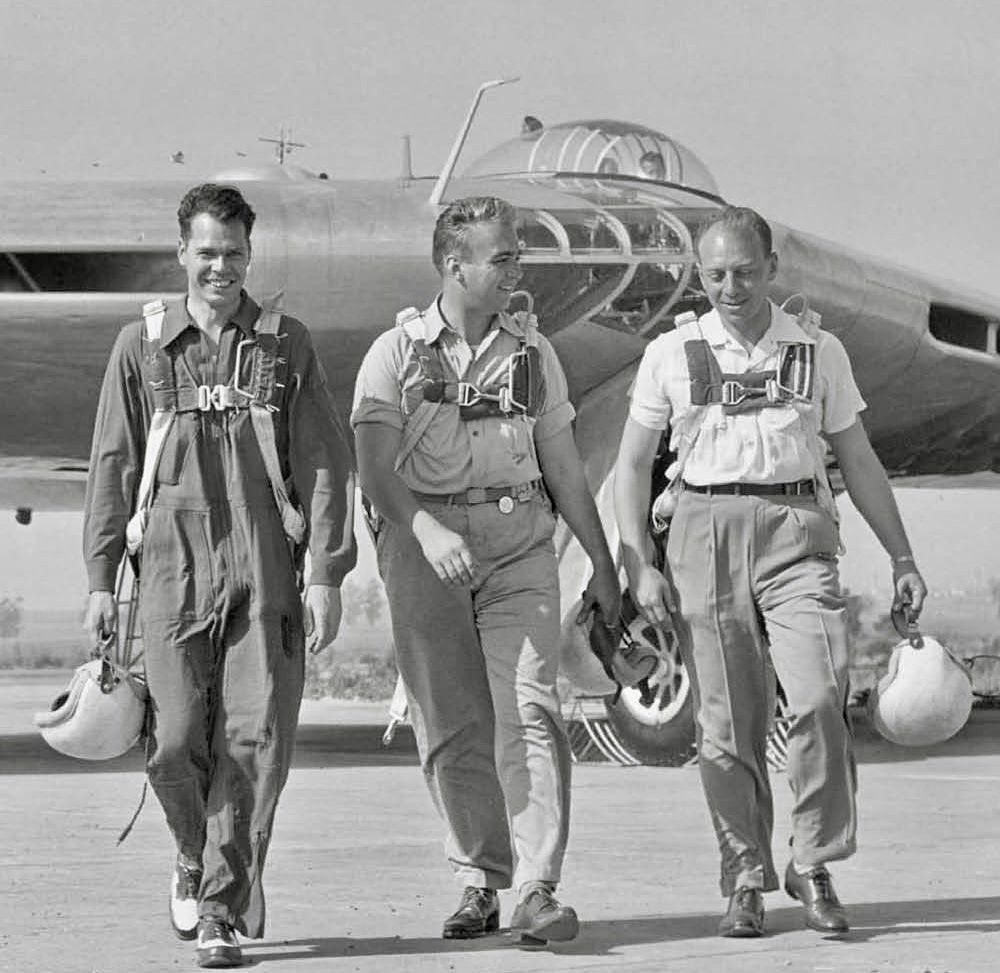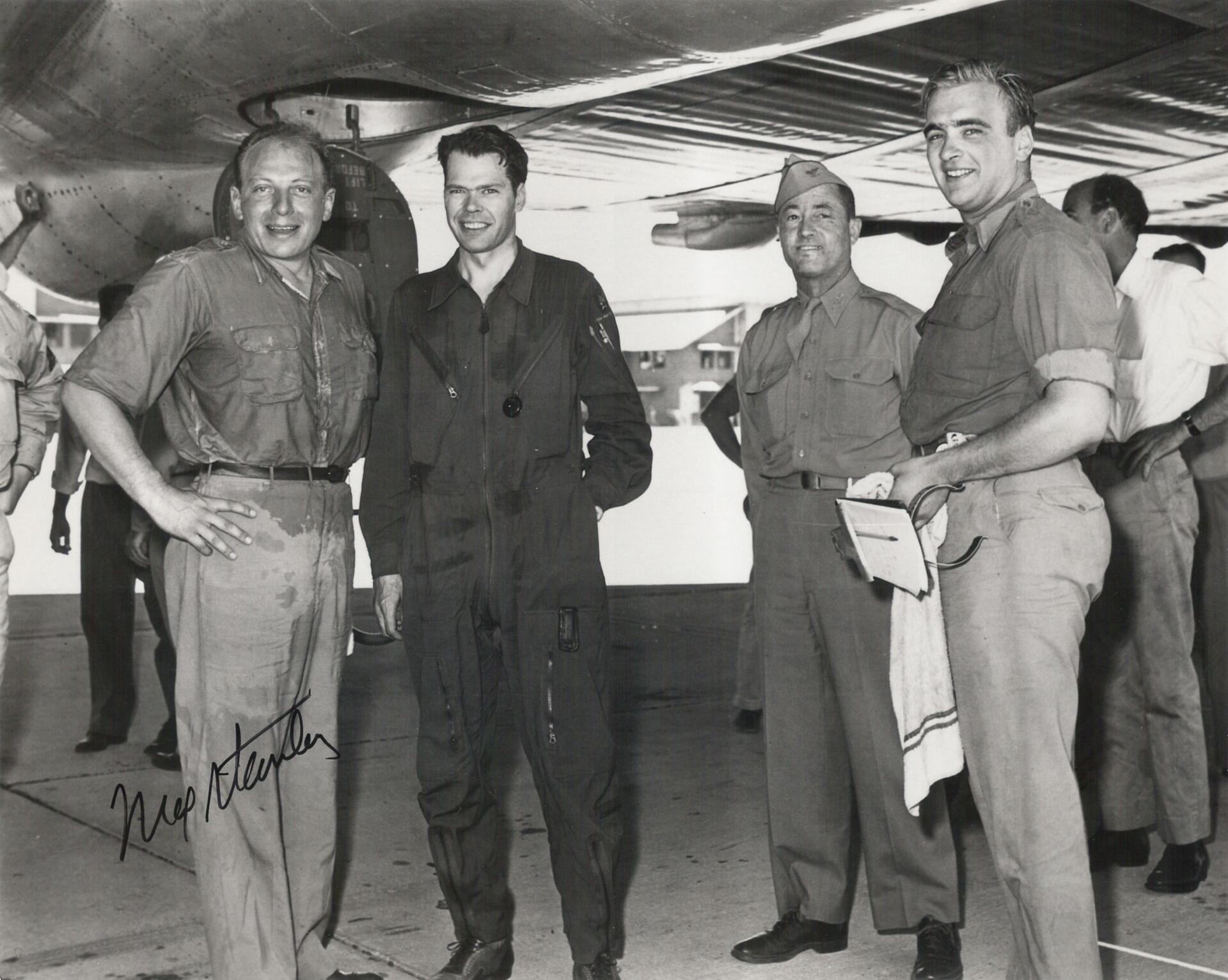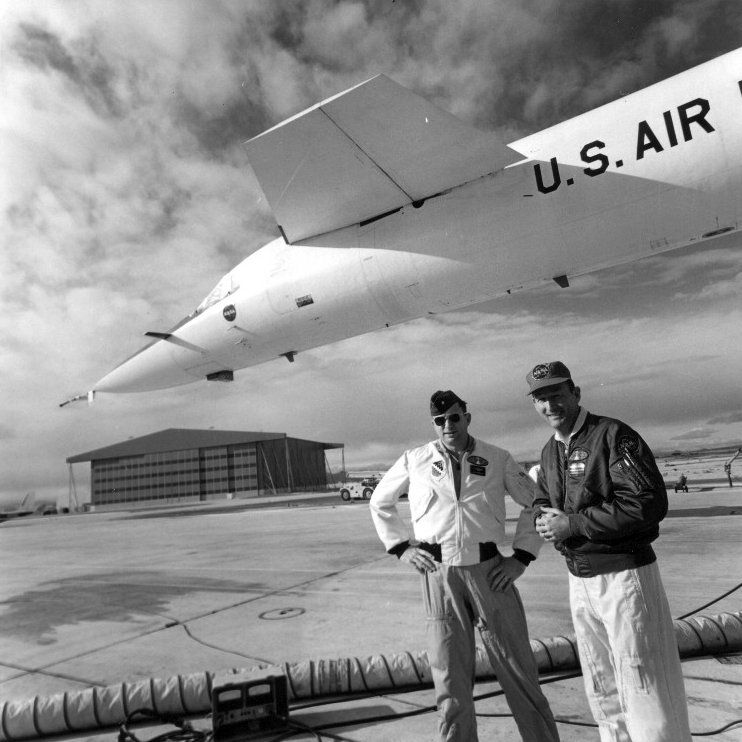LT. Col. Robert W. "Bob" Smith USAF - (1928-2010)
Bob Smith was born on December 11, 1928 in Washington, D.C. The seeds of flight were sown when he was about 10 years old by Bob’s uncle, who was a pioneer Naval Aviator. Uncle George Luckett was the 18th pilot of the United States Navy. Those seeds germinated with the news of the competition between the Air Force giant B-36 bomber and the Navy flying boats, during Bob’s second year of college and he enlisted as an Air Force Aviation Cadet, for pilot training. He trained for a year, first in the advanced trainer of WW II, propeller driven T-6 Texan, where his desire to fly the big bombers was pushed far in the background by the excitement of aerobatics and ‘dog-fighting’, so he earned selection to advanced training in one of the first classes for jet pilots flying the first truly operational jet fighter, the F-80A, Shooting Star. He graduated the day of the beginning of the Korean War.
Bob shipped to the 4th Fighter Wing in Korea, where he flew air-to-air combat in opposition to the Mig-15 jets flown by Russian and Chinese pilots. He was soon joined in the 335th squadron by those same two buddies, John Honaker and Billy Dobbs. Together they amassed a fine combat victory record, however only Bob would enjoy the results for very long as both died in aircraft disasters within a year. Bob’s first aerial combat encounter made him the wingman of the world’s third Jet Ace, but then pitted him against four Migs with their cannon working effectively in an all-out effort to destroy his wounded airplane, alone and over 200 miles from home base. His subsequent fights in the span of 100 missions resulted in successes and failures, before returning home to a squadron in the Air Defence Command, where he joined a team in a competition of aerial gunnery for the national title. That team was led by his commander in Korea and jet Ace ‘Bones’ Marshall. It was during that tour that he made a decision to finish college and get a degree in aeronautical engineering in hopes of becoming an Air Force Test Pilot.
Two years later, as a new engineer, he entered the Test Pilot School resulting in assignment to test flying at the Air Proving Ground Command. There he began to add to the more than 50 different types of military airplanes he would fly. That tour of duty included some unusual flying events and close calls during some of the greatest air demonstrations ever presented to the public. He details his challenges, his successes and his goofs, some of which were in the extreme. Among them was his opportunity to fly solo in the formation of the Air Force Thunderbird Team and be invited to join them as one of the team members. That honor was squelched when a powerful officer, decided that Smith’s education and experience would lend more in developing the growing ballistic missile force of the U.S. The ensuing and unhappy times had a redeeming opportunity and that was to be a significant part of the celebration of his favourite Air Force hero. The result was being part of a national TV show on NBC, ‘The Life of Jimmie Doolittle’, with the great man, himself.
That introduction, and a personal recommendation by General Jimmie led to Smith’s assignment to the new Aerospace Research Pilots School for astronaut training and his selection by the Air Force as one of nine candidates for the Gemini/Apollo astronauts. It also returned him to flight test at the Air Force’s premier test site, Edwards California. There he would become the Air Force test pilot for the NF-104A, AeroSpace Trainer, an effort to train future astronauts in actual space flight in a reusable Jet-Rocket craft, with normal take-off and landing. It was during that testing that he flew higher than anyone ever had under those conditions and set an altitude record for flight with ground take-off that would hold to this day, had it been officially sanctioned in Paris. That program would ultimately falter, as the result of an accident in one of the three aircraft, when Col. Chuck Yeager lost control and crashed, seriously injured.
The above is extracted from Bob's own excellent website and official on-line autobiography NF-104.com. Bob Smith sadly passed away on 10th August 2010.
Rogers E. Smith
Rogers Smith served as a pilot with the Royal Canadian Air Force from 1955 to 1963. He was a fighter pilot in the United States Air National Guard from 1970 until he concluded his service as a Group Commander of an F-16 Air Defence Unit in 1994. He has also served with the National Research Council of Canada, flying variable stability helicopters used for flying qualities research. Smith received a Bachelor of Applied Science degree in Engineering Physics in 1959 and a Master of Applied Science degree in Aeronautical Engineering in 1961, both from the University of Toronto, and both as an Honors Graduate.
Smith was associated with NASA's Langley Research Center in Virginia in 1967 as a research pilot, and has specialized in the areas of advanced flight control systems, stability and control, and flying qualities throughout his flying career. Before becoming a research pilot at Dryden in 1982, Smith was Chief Pilot for the Calspan Corporation, Buffalo, N.Y., where he was a project engineer and pilot on the X-22A V/STOL aircraft and on the variable stability NT-33A aircraft.
Smith was a project pilot on the SR-71 and F-15 "ACTIVE" projects. He has been a project pilot on the X-31 Enhanced Fighter Manoeuvrability Demonstrator project, and the F-104 aeronautical research aircraft. Since beginning his NASA career, Smith has also been a project pilot on the X-29 Forward Swept Wing, the Advanced Fighter Technology Integration F-16 (AFTI F-16), and the AFTI F-111 Mission Adaptive Wing research programs.
At Dryden, he was the Chief of the Flight Crew Branch for a number of years. In this position, often referred to as Chief Pilot, Smith headed the team of thirteen research flight crews (including himself) at NASA's premier installation for aeronautical research. He had held this position since January 1993 except for a period from July 27, 1998, until March 27, 2000, when he served as the Acting Director of Flight Operations at Dryden. As Acting Director, he managed the Avionics, Operations Engineering, Flight Crew, Quality Inspection, Aircraft Maintenance and Modification, and the Shuttle and Flight Operations Support Branches. Read Rogers Smith's NASA Armstrong biography .
Robert K. "Bob" Smyth - (1927-2012)
Bob Smyth was born in New York City on July 17, 1927. After one semester of college, he entered the U.S. Navy in June of 1945. While serving in the U.S. Navy, Bob furthered his college education and entered Naval Flight Training. He graduated in 1948. Bob was assigned to both fighter and night fighter squadrons flying Grumman F8F Bearcats, Chance Vought F4U Corsairs, and McDonnell F2H Banshees. He graduated U.S. Navy Test Pilot School in 1952, and served as exchange officer with the British Royal Navy flying De Havilland DH-112 Sea Venoms in 1953-54. In 1955 Bob resigned his commission from the U.S. Navy and accepted a position as an Engineering Test Pilot with the Grumman Aircraft Engineering Corporation. He flight-tested the F9F Cougar and F11F Tiger series, and participated in Gulfstream I Test and Certification program from 1955 to 1960. Bob performed the first flight of the A2F-1 (A-6A) Intruder in April 1960 and continued with the test phase of the program until November 1962.
He was then appointed as a consulting pilot and astronaut liaison on the Apollo Lunar Module program. In the spring 1966 he left the LM program and became the project pilot for the Gulfstream II, Grumman’s entry into the corporate jet market. Bob performed first flight on the Gulfstream II in October 1966 and participated with its test and certification program. In 1967 Bob was appointed Chief Test Pilot for Grumman. Several years later on December 21, 1970, along with fellow Grumman Test Pilot Bill Miller, he performed the first flight of the best fighter aircraft ever produced, the F-14A Tomcat. He also holds the distinction, as well as Bill Miller, as the first crew to eject from an F-14 on December 30 just a little over a week from first flight.
In 1972 Bob attended a program for Senior Executives at MIT, and was named Director of Flight Test in 1974. He was also the project pilot for the Gulfstream III, performed first flight in December 1979, and continued with its test and certification program. Bob left Grumman in 1981 and joined the Gulfstream Aerospace Corporation in Savannah, Georgia as Director of Flight Operations. In 1985 he was promoted to Vice President of Flight Ops and Quality Control. Bob also participated in most of the Gulfstream III and IV record setting flights around world, over the poles, etc. Some of Bob’s accomplishments in aviation include certified Airline Transport Pilot (G-I, II, III, and IV), and single engine land, multi-engine land and sea aircraft. He is a Fellow of Society of Experimental Test Pilots, and was elected to the Carrier Test Pilots Hall of Honor, on board USS Yorktown, Charleston, SC in 1991. In June of 1993, Bob retired from the Gulfstream Aerospace Corporation to Ocala, Florida. Bob Smyth sadly passed away 10th January 2012.
Colonel Donald M. "Don" Sorlie USAF - (1923-2016)
A combat veteran Sorlie flew 50 missions in the F-86 in the Korean war and 143 missions in the F-4 during the Vietnam war. Sorlie was a test pilot at Edwards AFB between 1955 and 1967 and was involved with testing all the "century" series fighters. Sorlie was the sixth man to pilot the M2-F1 lifting body and made his first of 5 flights on May 27th, 1965 and went on to make 3 flights in the M2-F2.
Sorlie was Chief of the Fighter Test Operations Branch at the Air Force Flight Test Center and was the official "boss" of the lifting body and X-15 Air Force test pilots. Don Sorlie was honored by the Flight Test Historical Foundation in 2005 at their "Gathering of Eagles" for his work in testing the Lockheed U-2. Colonel Sorlie sadly passed away on 9th August 2016, he was 93 years old.
SpaceShipOne Pilots
Burt Rutan's company Scaled Composites of Mojave, CA was the first to design, build and fly the first private manned vehicle to fly in space. On June 21st, 2004 pilot Mike Melvill flew the little rocket-ship to an altitude of 328,491 feet or approximately 62 miles high!! Melvill also flew the first "X-Prize" flight on September 29th, 2004 when he and SS1 reached an altitude of 337,500 feet or 63.9 miles. The second "X-Prize" flight was made on October 4th, 2004 when pilot Brian Binnie flew the little rocket-ship to an altitude of 367,442 feet or 69.6 miles high!! This broke the August 22, 1963 record by Joseph A. Walker, who flew the X-15 to an unofficial world altitude record of 354,200 feet. For more information on the pilots, Scaled Composites and the spacecraft itself please visit SpaceShipOne. The cover in the gallery (my design) was cancelled at Mojave on the date of the first Private Manned spaceflight; June 21, 2004. Signed by SS1 pilot Mike Melvill.
Max R. Stanley - (1910-1999)
Max R. Stanley logged more than 8,000 flight hours to become known as the "Dean of Northrop Test Pilots." He flew the first flights of all models of the Northrop P-61 Black Widow except the initial XP-61. Stanley flew for Lockheed Aircraft, Pan American Airways and United Airlines before joining Northrop Aircraft as an Experimental Test Pilot in 1943. During his 28 years with Northrop, he pioneered as pilot on the first flights of the Northrop F-15, the Tri-Motor C-125 Raider, and participated as pilot in the F-89 Scorpion and T-38 Talon flight test programs.
He served as a Project Pilot on the Northrop N-9M one-third scale model of the large XB-35 Flying Wing Bomber. Stanley was selected as Chief Pilot on the entire XB-35 contractor flight test program including the first flight. He also served as Chief Pilot on the first flight of the eight-jet YB-49 flying wing. He was later assigned as Chief Pilot and Director, Flight Operations in the development of the SM-62 SNARK Intercontinental Cruise missile. He flew a number of manned aircraft, which were used in the design phase of the full scale, operational missile: P-61, F-89, C-47, P-80, B-45 and B-29. Stanley is a Founding Member and Fellow of the Society of Experimental Test Pilots and long-time Chairman of its Scholarship Foundation. He also helped found and served as President of the Aviation Country Club of California. He is a two time recipient of Caterpillar Club membership, twice earned when he used his parachute to save his life. Stanley is the recipient of the Barnstormer Trophy for "Distinguished Accomplishments in Aviation" and was inducted into the City of Lancaster's "Aerospace Walk of Honor in 1993.Max Stanley sadly passed away in 1999 at age 89.
Colonel Emil "Ted" Sturmthal USAF ret - (1929-1982)
Air Force Col. Emil "Ted" Sturmthal co-piloted the first B-1 bomber flight in 1974, continuing at the controls for the initial six flights, taking it to supersonic speeds for the first time. Prior to that, he flew 196 combat missions in the B-26 in Korea before graduating from the Air Force Test Pilot School in 1959. Sturmthal was one of seven pilots of the Mach 3 XB-70 flight research program and made the first flight of the then-secret RB-57F reconnaissance aircraft. He also served as project pilot on a number of programs, including the B-58 flight control modification program, T-37B, Navy C-130BL, B-52H.
Like many celebrated pilots, Sturmthal's interest in flying began at an early age. However, he wore thick glasses, usually an insurmountable obstacle for military pilots. Determined to become a test pilot, he flew his own airplane to the capital and convinced Gen. Hoyt Vandenburg, Air Force Chief of Staff, for a waiver. With that, he became the first pilot to go through Air Force pilot training with eyeglasses. By 1976 Sturmthal logged almost 8,000 hours of flying time in more than 50 kinds of military aircraft and 4,000 hours in civilian aircraft. Colonlel Sturmthal sadly passed away in 1982.


































